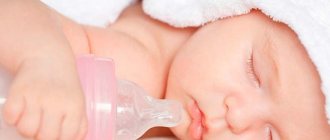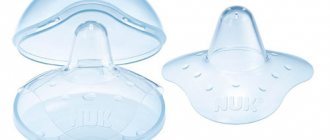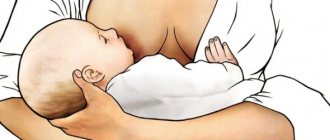Breastfeeding a newborn baby is the most natural state for every young mother. By doing this, she gives him her love and protection, strengthens the immune system, maintains close tactile and psychological contact, which is very important and necessary for the proper development of the baby. But even with the most successful breastfeeding, there comes a time when a mother begins to wonder how to wean her child, who is already quite grown and strong enough, from breastfeeding.
Video: when to wean a baby?
What is not a reason for excommunication?
Every fourth mother gives an argument in favor of giving up breastfeeding: “I feel like it’s time.” But, despite the close connection with the baby, you only need to take into account scientific concepts and medical evidence.
You should not make a decision to wean if the child refuses milk. This is often associated with physiological fluctuations in the child’s body, for example, a decrease in hemoglobin, disturbances in the gastrointestinal tract. It is breast milk that will become the primary medicine in these cases, and weaning will cause complications.
Eating complementary foods and the ability to eat from a plate is not a reason to stop breastfeeding. The composition of milk is not comparable in nutritional value to artificial mixtures and cereals. Properties last up to 2-3 years. Therefore, WHO recommends continuing natural nutrition until the baby is weaned from breastfeeding [2].
Unjustified reasons for weaning
- Lack of appetite in the child.
- Frequent waking up at night.
- Mom goes to work.
- The need to send the baby to a kindergarten or nursery (up to one and a half years).
Sometimes a mother thinks about stopping natural feeding because of the desire to get enough sleep. However, the opinion that a bottle-fed baby will wake up less often is incorrect. The child will continue to require reassurance, mother’s warmth, and rocking, since the cause of anxiety lies in the peculiarities of the infant’s sleep cycle.
A baby older than one year reacts more calmly to the lack of mother's milk, since his digestive system is already adjusted to the new regime. But even a working mother will help her baby adapt better if she continues breastfeeding in the evening and at night. Milk will support the baby’s immunity, and contact during evening feedings will soothe the child who misses his mother. During business trips, it is recommended to express milk rather than suppress lactation.
The need to attend kindergarten for a child under one and a half years old often serves as a reason for weaning from natural feeding. But even in this situation, stopping breastfeeding is unjustified.
After a year, the baby needs to learn to fall asleep without his mother; the skill will stabilize after 2-3 weeks. Dense feeding remains in the morning and before bedtime. Breastfeeding will help the child adapt to kindergarten in a stressful situation.
Mom should think carefully about the need to stop breastfeeding. After all, 3 breastfeedings (700-750 ml) cover ½ of the baby’s daily need for energy and protein, 50% for vitamin A, and 100% for ascorbic acid and tocopherol. Breastfeeding in combination with complementary foods is the key to the full development and health of the child.
What not to do when your child is 1-2 years old
How to wean a baby from breastfeeding before one year
When it is necessary to wean a child from breastfeeding is an individual question for any child. You should not put pressure on the child, “squeeze” him in an attempt to meet the scheduled deadlines and plan. A rollback may occur, and the baby will “hang” on the chest even more than before, because he will be afraid of losing it again.
Replacing breastfeeding with formula milk
Important! If a child has a negative reaction to the end of guardianship, he should be given time to adapt and delay weaning.
What not to do if your child is 1-2 years old:
- Set a specific deadline and date when the child will no longer be on guard duty;
- If the baby has a strong emotional shock (he hit himself, was afraid that he had lost his mother), you should not deny him the breast;
- Do not resort to rapid weaning - the departure of the mother, if the child has an anxious attachment to her. Upon her return, he will begin to demand even more attention or become very withdrawn into himself;
- Do not smear the nipples - this will be extremely stressful for the baby, since for him the breast is the personification of kindness and calm. If “trouble” happened to her, this will turn the child away from his mother for a long time.
"Pros and cons"
Weaning a baby from 1-2 years of age is not an easy task. At this time, he still needs the breast, but, on the other hand, he has the opportunity to insist on his own.
If the mother suddenly wanted to “remove” the breast, then the unsatisfied need begins to “come out” in other states: neuroses, whims, hysterics. Although weaning may seem necessary due to accumulated fatigue and lack of sleep, abrupt weaning will add even more problems and spoil the family climate.
The best solution is to write the solution to the problem on a piece of paper. For example, in case of poor quality sleep at night, you can sleep with your baby during the day.
Whether to reduce the number of feedings gradually or abruptly wean – the decision is up to the mother. If the child is ready for weaning, then it is allowed to force things a little. If attachments are frequent, then you need to give yourself and the baby time for several months.
Bad time to wean: pediatrician's opinion
If the question arises about stopping breastfeeding, it is necessary to determine periods when this should not be done. When weaning, the child is already experiencing stress, so it is necessary, if possible, to exclude additional disturbing factors.
Risk situations: summer, stress and illness
- Stress: moving, mom going to work, hiring a nanny, going to nursery.
- Illness and recovery period.
- Days before and after vaccinations.
- Summer months.
Pediatrician E. O. Komarovsky claims that weaning during stressful periods will worsen the child’s nervousness and fear. The baby develops a feeling of uselessness, which provokes moodiness and anxious sleep. The age of risk is considered to be 1 and 3 years, as well as the period of illness. It is recommended to start weaning a child from breastfeeding 2-3 months after a stressful situation.
Vaccination is also considered a stressful moment for the baby’s psyche and physiology. After vaccination, immunity is reduced, leaving a feeling of resentment and fear. Only breast milk can replenish protective resources; stress “releases” after sucking the breast and hugging the mother.
Why can’t we wean off breastfeeding in the summer?
Pediatricians say that summer is a bad time to wean your baby from breastfeeding, as the risk of contracting intestinal infections increases by 40% in the warm months. After breastfeeding stops, the tension of the immune system decreases, and the child’s body becomes vulnerable to the action of pathogens. Mother's milk acts as a protective barrier against infection.
The second factor against weaning off breastfeeding in the summer is the risk of dehydration. In the heat, fluid loss is replenished only by drinking. But the baby does not immediately learn to drink the daily amount of water, because he previously received some of it with milk. It takes time to develop a skill, but if the air temperature goes through the roof, it is unacceptable to hesitate.
The best period to stop breastfeeding is autumn and winter, but age plays a major role. If the baby is less than a year old, then stress for him and for the mother is an integral part of the weaning period.
When to start this process?
One of the most important pieces of advice about when is the best time to wean your baby off breastfeeding is this: you need to make this decision yourself. There is no need to listen to the advice of friends and relatives about when to stop breastfeeding . After all, weaning from breastfeeding occurs at different times for everyone, and due to various factors, each mother tries to wean her baby at a certain period.
Some people can’t wait to finally stop being closely dependent on the baby, some strive to quickly restore their “pre-pregnancy” shape, others need to join the work schedule at some point. However, there are also less clear reasons why a child is stopped breastfeeding at a certain period. For example, you can still hear the belief that after some time milk becomes not only useless for the baby, but even harmful. There is no doubt that you should not believe such incomprehensible theories.
For those for whom the question of when and how to wean a child correctly from breastfeeding is relevant, you need to rely on the evidence of science and medicine. Therefore, it is important to understand exactly how milk production occurs in the body. It is produced due to the influence of the hormone prolactin . If the mother feeds the baby regularly, the amount of milk does not decrease even after a long time. And if the mother’s nutrition is complete, then the composition of mother’s milk will be as rich as in the first months after the start of feeding.
Therefore, weaning a child from breastfeeding is carried out no earlier than the baby turns one year old, of course, unless there are emergency reasons for this. If you follow WHO recommendations, then you need to stop natural feeding no earlier than the baby turns 1.5-2 years old. However, when weaning, one must first of all be guided by individual characteristics. It is very important that both mother and child are prepared for this process.
Feeding is a process that unites a woman and her baby. Therefore, she must be psychologically prepared for the fact that such contact will be broken.
It is not recommended to stop natural feeding too early, because until the age of 1-1.5 years the baby may not be ready for this. In addition, in such a situation, negative consequences may also appear for the mother, who under such conditions increases the risk of lactostasis , the appearance of painful lumps in the breast. With premature weaning, an early restructuring occurs in the body, which is fraught with the development of hormonal disorders, as well as prolonged release of milk from the breasts after the cessation of feeding.
It's time to wean your baby off breastfeeding: the best time
The main factor indicating a woman’s readiness to stop breastfeeding is the absence of breast milk or a critical minimum of glandular filling. The observed time period is 12 hours. To check your milk supply, you need to stop feeding and express the milk. For mothers whose children attend nurseries, there will be no problems. It is easy to determine a decrease in lactation by the volume of expressed fluid or by the feeling of breast fullness.
A characteristic sign of a decrease in breast milk: in the absence of night feedings, there is no milk in the morning. It is important not to confuse this phenomenon with blocked ducts. A symptom of lactostasis is soreness, compaction in the glands.
If milk decreases with the same diet and regimen, it’s time to stop lactation.
Determining whether the baby is ready is more difficult. It is recommended to continue feeding until prolactin is produced. Normally, this period lasts 1.5-2 years without failures.
How do you know when it's time to stop feeding your baby?
When answering this question, you need to consider it from the perspective of both mother and baby, since this process is not easy for both.
So, for a woman, the main factor indicating her readiness to stop breastfeeding is the lack of breast filling for a long time - from 12 hours.
There are several ways to determine how long milk has not been produced. It will be very easy for mothers of babies who go to kindergarten to understand that the milk is not coming. If a mother does not feed her baby at night, then if there is no milk in the breast during the day, you can understand that it is decreasing. In this case, the woman should not feel pain in the mammary glands, and lumps should not form in them.
Sometimes it is difficult for a woman to restrain herself from feeding her baby during the day. In this case, you can leave the baby with one of your relatives so that there is no temptation to feed the baby.
If the mother is unable, for certain reasons, to apply the methods described above, then you can feed the baby from only one breast throughout the day, and watch the other.
Provided that the breasts do not fill within 12 hours, you need to count from 8 to 12 weeks, and after that the time will come when the woman’s body is completely ready to stop lactation.
But determining whether the baby is ready for weaning is more difficult. But still, every mother feels exactly what her baby needs and when, so it will be easiest for her, sometimes even on an intuitive level, to determine when the baby is ready for weaning.
However, every mother should think correctly in this case. An important criterion is the baby’s refusal of bottles, pacifiers, and pacifiers. Breastfeeding should be done from 1 to 3 per day. Moreover, this exact amount should be constant for 1-2 months. As a rule, such a period begins and, accordingly, weaning from breastfeeding at 2 years. True, you should take into account the individuality of the process and understand that this can happen a little earlier and a little later.
Ways to wean a child from breast milk at 1 and 2 years of age
There are 3 ways to stop breastfeeding - soft, emergency, medicinal. And, if the mother is unequivocal, WHO recommends strictly following the instructions for proper (gentle) weaning from breastfeeding.
The gentle method in 5 steps
- Eliminate intermediate feedings - to calm the baby when the mother thinks he is hungry (the situation is typical for feeding on demand). It is better to try to calm the child down with hugs, rocking, or singing a song. If you are sure that anxiety is due to hunger, introduce complementary foods.
- Stop feeding after a nap - immediately distract the child with a favorite toy or a new game. It is recommended to remove 1 feeding per week. If the baby has a hard time refusing, the second feeding is excluded after 2 weeks. For 3 weeks, a morning-evening regime is established.
- Eliminate daytime feeding - after breakfast, replace sleep with a walk (2-3 hours). After returning, feed the baby soup, give tea and cookies and put him to bed with a fairy tale. Afternoon snack without feeding (see point 2).
- Stop breastfeeding in the morning - after a week, one breakfast every 7 days is replaced with complementary foods, eliminate 1 feeding per week. The actions are similar to step 2.
- Eliminate feeding before bedtime - 2 weeks before the complete cessation of breastfeeding, add a new bedtime ritual. For example: a bath with chamomile - a glass of milk - a fairy tale. At first, breastfeeding is allowed at night (along with the ritual); after 5-7 days, sucking is canceled. In the first 4-6 weeks, it is better for the father to put the baby to bed.
It is important to replenish the water deficit that occurs with the cancellation of each feeding. A baby needs 50 ml/kg body weight per day. The norm is calculated taking into account that milk satisfies 90% of the daily fluid requirement.
For example, a 1-year-old child weighing 10 kg requires 500 ml of water - this is 3 full feedings. When there is a shortage of normal nutrition with natural nutrition (for example, there are 2 feedings left per day), the baby is supplemented with water from a spoon or bottle.
Rapid weaning methods
Methods when you need to quickly wean a child from the breast are used only in extreme cases. Including severe illnesses of the mother: HIV infection, tumor, open form of tuberculosis, purulent mastitis; when using chemotherapy to treat a woman. The methods are traumatic for mother and child.
- Mom's departure - 3-5 days, transition to formula. A double stressful situation for the baby: interruption of tactile communication and unsatisfied sucking reflex.
- Breast constriction – risk of mastitis 44%. Psychologically difficult for the child, dangerous for the mother.
- The use of hormonal drugs is a modern way to suppress the production of prolactin. Valid for 12 hours. Severe adverse reactions are observed due to sudden changes in hormonal levels.
When using medications that are incompatible with feeding, breastfeeding is recommended to be suspended, but not stopped. At this time, the milk is expressed. After completing the course of treatment, it is better to continue natural feeding, especially if the child is less than one and a half years old.
The best way to abruptly wean a baby with minimal risks is to take hormonal medications. The effect comes from one tablet. It has an irreversible effect if the production of prolactin is not provoked by putting the baby to the breast.
Prolactin inhibitor tablets
- Dostinex;
- Cabergoline;
- Bergolak;
- Agalates;
- Bromocriptine.
The drugs have side effects in 65-70% of cases taken. Manifestations: nausea, vomiting, dizziness, tachycardia, decreased blood pressure. Symptoms are observed for 2-5 days, then disappear.
Expert opinion
Sokolova L. S.
Pediatrician of the highest category
To wean your baby from breastfeeding without harm to his health, you need to follow the instructions of the gentle method step by step. The main advantage: the child’s immunity, nervous and hormonal systems painlessly adapt to a new diet. The mother is calm, the child is happy.
Weaning a baby up to one year
The World Health Organization states that breast milk is the only way to increase a baby’s body’s resistance to various infections. That is why weaning children under one year old is allowed in extreme cases. The stress that the baby will experience is tantamount to parting with his mother.
If the situation requires weaning your child off breastfeeding early, it is recommended to do this before 10 months or 8-12 weeks after the first birthday. Pediatricians consider the age of one to be a critical moment in a child’s mental and physical maturity. Weaning at 11-13 months threatens the baby with allergies, gastrointestinal disorders, and decreased immunity. The result is frequent colds and infections.
How did I prepare and wean my baby in a week?
Before separating the baby from the breast, he must be prepared for this difficult test. This will not be easy to do. You will need parental warmth, tenderness and love. The preparatory process lasts for some a week, and for others a couple of months. It all depends on the child's temperament. I will tell you about my personal experience, how it all happened for me.
I weaned for 3.5 months. The first thing I did was refuse to feed the baby before naptime. Yes, it was not easy, but very important. When my baby stopped nursing in the afternoon, he began to fall asleep alone without his mother during the day, and it became easier to go to bed in the evening. I didn’t give in to the child’s tantrums. I tried to lie next to him, read a fairy tale, sing him a song, calmed him down by any means, but the breast did not give.
Second, I reduced my daily feedings to three. She let me breastfeed in the morning, at midday and at night.
If the baby still cannot live without his mother at all, you can reduce breastfeeding to 4 times a day at first.
Third, morning sucking, I did not force the baby to suck. If the baby forgot about the breast in the morning, I didn’t remind him of it. The baby played and minded his own business.
But it also happened that he remembered about the chest closer to lunch. Then I tried to explain that it was too late for a morning snack and early for an afternoon snack. She distracted my son and offered to go and look at dad through the window or grandma through the peephole in the door. This is how I gradually managed to wean myself off morning sucking.
The fourth, midday feeding was short-lived. She allowed me to suck for no more than 15 minutes. I reduced this time by 2 minutes every 2-3 days. Thus, I weaned her at midday.
Fifth, I weaned her off night feeding. As soon as this became the only feeding for the day, I boldly began to break this thread between us. It was easier to do this. Before going to bed, I fed him good porridge or some kind of puree, in a word, so that the baby would eat and not snack. She gave me tea or kefir to drink and went to bed. She held her close, read a book or sang a lullaby. Tired, satisfied and well-fed, the child quickly fell asleep throughout the night.
That's how we weaned ourselves off breastfeeding. There were hysterics, scandals and a sea of tears every evening. But I gained strength and patience, and we succeeded.
Breasts during weaning
If a gentle method is used, milk continues to be produced for 4-8 weeks. With an abrupt cessation of breastfeeding (without pills), congestive glandular diseases are diagnosed in 20% of cases. Lumps form in the breast and an abscess may develop. More often, complications appear on the 3rd day after complete cessation of breastfeeding and are accompanied by severe pain and inflammation. To eliminate these problems, special recommendations have been developed.
Rules for breast care during forced cessation of lactation
- If the weaning was abrupt, it is better to express milk according to the principle of the soft method - gradual curtailing of breastfeeding.
- Carry out the procedure 4-5 times a day until the breasts are soft, reduce the number of pumpings every 5 days.
- When expressing, leave a little milk - this way it will “burn out” faster.
- Wear a bralette made of cotton fabric.
- Drink herbal decoctions and teas - mint, lingonberry, sage, parsley.
- To relieve inflammation, use cool compresses (hot ones are not allowed).
- For pain relief, chilled cabbage leaves (brushed first) are recommended.
- In case of severe pain or a temperature above 38.0°C, you can take paracetamol.
- It is allowed to take sedatives at night (Valocordin, motherwort).
- If inflammation and pain increase, you need to contact a mammologist.
Unpleasant sensations normally go away after 2 weeks. The mild method of weaning is less often accompanied by inflammation of the glands.
Lumpiness in the breast is the first sign of lactostasis. It is necessary to consult a doctor to determine tactics for further cessation of lactation.
When milk stops coming out completely
As a rule, with the smooth end of feeding, lactation gradually stops. Therefore, the question of what to do with breast milk after weaning is, as a rule, not relevant. Provided that milk is released and the woman skips feeding, it needs to be expressed. Pumping is carried out only until a feeling of relief appears. When expressing, the amount of milk decreases every day. After expressing, it is recommended to make a cold compress or apply cold cabbage leaves to the breast.
It is also recommended to drink tea with sage and peppermint 4-5 times a day. If lumps, redness or tenderness appear in the breast, you should consult a doctor to prevent the condition from worsening.











